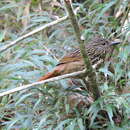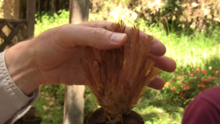en
names in breadcrumbs


Aderyn a rhywogaeth o adar yw Heliwr coed rhesog (sy'n enw gwrywaidd; enw lluosog: helwyr coed rhesog) a adnabyddir hefyd gyda'i enw gwyddonol Thripadectes holostictus; yr enw Saesneg arno yw Striped treehunter. Mae'n perthyn i deulu'r Adar Pobty (Lladin: Furnariidae) sydd yn urdd y Passeriformes.[1]
Talfyrir yr enw Lladin yn aml yn T. holostictus, sef enw'r rhywogaeth.[2]
Mae'r heliwr coed rhesog yn perthyn i deulu'r Adar Pobty (Lladin: Furnariidae). Dyma rai o aelodau eraill y teulu:
Rhestr Wicidata:
rhywogaeth enw tacson delwedd Cropiwr coronog Lepidocolaptes affinis Cropiwr daear pigsyth Ochetorhynchus ruficaudus Cropiwr daear y graig Ochetorhynchus andaecola Cropiwr pen rhesog Lepidocolaptes souleyetii Cropiwr sythbig Dendroplex picus Cropiwr Zimmer Dendroplex kienerii Heliwr coed bronresog Thripadectes rufobrunneus Heliwr coed penresog Thripadectes virgaticeps Heliwr coed pigddu Thripadectes melanorhynchus Heliwr coed plaen Thripadectes ignobilis Heliwr coed rhesog Thripadectes holostictus Heliwr coed rhibiniog Thripadectes flammulatus Rhedwr bach y paith Ochetorhynchus phoenicurusAderyn a rhywogaeth o adar yw Heliwr coed rhesog (sy'n enw gwrywaidd; enw lluosog: helwyr coed rhesog) a adnabyddir hefyd gyda'i enw gwyddonol Thripadectes holostictus; yr enw Saesneg arno yw Striped treehunter. Mae'n perthyn i deulu'r Adar Pobty (Lladin: Furnariidae) sydd yn urdd y Passeriformes.
Talfyrir yr enw Lladin yn aml yn T. holostictus, sef enw'r rhywogaeth.
The striped treehunter (Thripadectes holostictus) is a species of bird in the family Furnariidae with a dusky-brown coloring with prominent buff streaking on the wings, throat, and breast. It is found in humid to wet montane forest that range locally in the Andes from west Venezuela to west Bolivia (Bolivia, Colombia, Ecuador, Peru, and Venezuela) most often at elevations of 1500–2500 m. It is most often mistaken for and with the larger flammulated treehunter due to many physical and behavioral similarities.
The striped treehunter belongs to the order Passeriformes in the family Furnariidae. Passeriformes encompasses more than half of the known avian species which are known as perching birds. The Furnariidae are ovenbirds which are native to Central America and South America which are a diverse group of insectivores known for their "oven-like" nests. The genus Thripadectes contains six close relatives of the striped treehunter. There are three subspecies:

The average size is 20–21 cm in length. Dorsally, the striped treehunter has prominent streaks with buffing on the wings and a rufescent rump and tail. Ventrally, the striped treehunter is rufous with buff streaking on the throat and breast. The straight beak is black in color. One distinguishing characteristic from woodcreepers is the rounded rectrices tips while woodcreepers have spines at the tips
The song is a fast-paced, rising and falling tone "tr'r'r'R'E'E'E'E'E'R'r'r'r'r". The call is a sharp "kwi-di-dik".
The striped treehunter greatly varies in abundance where it ranges from uncommon to fairly common locally and regionally. It is most common in Ecuador (especially in Pichincha Province) where it is uncommon in Colombia and Venezuela. Being a shy bird, it is most often noticed through its vocalizations instead of visual observation.
It is commonly found in the undergrowth of montane forest in subtropic and temperate zones of both Andean slopes with abundant mosses, epiphytes, and dense understory. It is most often seen at elevations of 1500–2500 m, but varies by country (2,000–2,300 m in Ecuador, 100–2,700 m in Colombia, 1,800–2,000 m in Venezuela).
The striped treehunter is a furtive species; it is difficult to observe, often exhibiting similar behavior to that of the flammulated treehunter.
The birds often burrow into a steep bank or vegetation-covered roadcut.
The birds forage in dense cover 1–2 m above the ground, favoring Chusquea bamboo stands. Largely solitary birds, they are not commonly found in mixed flocks.
The striped treehunter (Thripadectes holostictus) is a species of bird in the family Furnariidae with a dusky-brown coloring with prominent buff streaking on the wings, throat, and breast. It is found in humid to wet montane forest that range locally in the Andes from west Venezuela to west Bolivia (Bolivia, Colombia, Ecuador, Peru, and Venezuela) most often at elevations of 1500–2500 m. It is most often mistaken for and with the larger flammulated treehunter due to many physical and behavioral similarities.
El trepamusgos listado[4] (en Perú) (Thripadectes holostictus), también denominado trepamusgos frangeado (en Ecuador), hojarasquero menor o mediano (en Colombia) o trepapalo listado (en Venezuela),[3] es una especie de ave paseriforme de la familia Furnariidae propia de regiones andinas del noroeste y oeste de América del Sur.
Se distribuye de forma disjunta a lo largo de la cordillera de los Andes, desde el oeste de Venezuela, por Colombia, Ecuador, Perú, hasta el centro de Bolivia.[5]
La abundancia del trepamusgos listado varía mucho a lo largo de su área de distribución, siendo infrecuente en unas partes, a muy corriente en otras. Es más abundante en Ecuador (especialmente en la provincia de Pichincha), y es poco frecuente en Colombia y Venezuela. Es un pájaro tímido, más fácil de oír que de observar.
Esta especie es considerada poco común en su hábitat natural, el denso sotobosque de bosques tropicales húmedos montanos de las laderas andinas, abundantes en musgos, y epifitas, principalmente en altitudes entre 1500 y 2500 m,[6] pero varía con la latitud (2000 a 2300 m en Ecuador, 100 a 2700 m en Colombia, 1800 a 2000 m en Venezuela).
Mide entre 20 y 21 cm de longitud y pesa entre 38 y 49 g.[5] Es un pájaro de plumaje de tonos pardo con un denso veteado anteado en la cabeza, espalda y partes superiores, especialmente en el pecho y la garganta. Su obispillo y cola son de color castaño rojizo. El fondo del plumaje de las partes inferiores también es castaño rojizo. Su pico negro es robusto y recto.
Tiene un aspecto muy similar al trepamusgos flamulado, aunque este último es de mayor tamaño. Una característica que distingue a los trepamusgos de los trepatroncos es las punta redondeada de sus colas, mientras que los trepatroncos presentan bordes espinosos.
El trepamusgos listado es una especie huidiza, difícil de observar, y con un comportamiento similar al trepamusgos flamulado.
Busca alimento entre la vegetación densa del sotobosque entre 1–2 m del suelo, con preferencia por los matorrales de bambú Chusquea. Principalmente son solitarios, pero pueden encontrarse en bandadas mixtas.
Suele hacer túneles en taludes y terraplenes escarpados cubiertos de vegetación.
El canto es semejante al del trepamusgos flamulado, un trinado rápido, staccato, de notas ásperas, de timbre equilibrado, pero el canto de la presente especie es más rápido, de timbre más alto y descendiente hacia el final.[6]
La especie T. holostictus fue descrita por primera vez por los zoólogos británicos Philip Lutley Sclater e Osbert Salvin en 1876 bajo el nombre científico Automolus holostictus; su localidad tipo es: «Medellín, Antioquia, Colombia».[5]
El nombre genérico masculino «Thripadectes» deriva del griego «thrips, thripos»: carcoma, polilla de la madera, y «dēktēs»: picoteador; significando «que picotea la polilla de la madera»;[7] y el nombre de la especie «holostictus», proviene del griego «holos»: completo, entero y «stiktos»: moteado, punteado; significando «enteramente moteado».[8]
La subespecie striatidorsus es de dudosa distinción de la nominal; adicionalmente, las aves del norte de Perú (Amazonas al sur hasta La Libertad, de donde se desconocían especímenes hasta recientemente) tienen la coloración ventral y la extensión del estriado intermediaria entre la subespecie nominal y moderatus, y esta última exhibe una tendencia creciente hacia la nominal en la poblaciones más al norte, y el tamaño del cuerpo significativamente menor en el extremo sur; análisis cuantitativos, incluyendo especímenes de las localidades intermediarias, podrían mostrar que toda la variación geográfica es clinal y que no se sustentaría ninguna división en subespecies.[5]
Según las clasificaciones del Congreso Ornitológico Internacional (IOC)[9] y Clements Checklist v.2018,[10] se reconocen tres subespecies, con su correspondiente distribución geográfica:[5]
|formato= requiere |url= (ayuda)) (en inglés). Año:2018. El trepamusgos listado (en Perú) (Thripadectes holostictus), también denominado trepamusgos frangeado (en Ecuador), hojarasquero menor o mediano (en Colombia) o trepapalo listado (en Venezuela), es una especie de ave paseriforme de la familia Furnariidae propia de regiones andinas del noroeste y oeste de América del Sur.
Thripadectes holostictus Thripadectes generoko animalia da. Hegaztien barruko Furnariidae familian sailkatua dago.
Thripadectes holostictus Thripadectes generoko animalia da. Hegaztien barruko Furnariidae familian sailkatua dago.
Viiruorneero (Thripadectes holostictus)[2] on orneeroiden heimoon kuuluva varpuslintu.
Viiruorneeroa tavataan Boliviassa, Ecuadorissa, Kolumbiassa, Perussa ja Venezuelassa. Lajia on kuvattu melko yleiseksi, ja se on luokiteltu elinvoimaiseksi.[1]
Viiruorneero (Thripadectes holostictus) on orneeroiden heimoon kuuluva varpuslintu.
Thripadectes holostictus
L'Anabate strié (Thripadectes holostictus) est une espèce d'oiseaux de la famille des Furnariidae.
Son aire s'étend sur la moitié nord des Andes.
De gestreepte boomjager (Thripadectes holostictus) is een zangvogel uit de familie Furnariidae (ovenvogels).
Deze soort komt voor van centraal Colombia tot centraal Bolivia en telt 3 ondersoorten:
De gestreepte boomjager (Thripadectes holostictus) is een zangvogel uit de familie Furnariidae (ovenvogels).
Strimmig trädletare[2] (Thripadectes holostictus) är en fågel i familjen ugnsfåglar inom ordningen tättingar.[3] IUCN kategoriserar arten som livskraftig.[1]
Strimmig trädletare delas in i tre underarter:[3]
Strimmig trädletare (Thripadectes holostictus) är en fågel i familjen ugnsfåglar inom ordningen tättingar. IUCN kategoriserar arten som livskraftig.
Strimmig trädletare delas in i tre underarter:
Thripadectes holostictus striatidorsus – förekommer i Anderna i sydvästra Colombia (Nariño) och västra Ecuador Thripadectes holostictus holostictus – förekommer i Anderna från Colombia till sydvästra Venezuela, östra Ecuador och norra Peru Thripadectes holostictus moderatus - förekommer i subtropiska östra Peru (Junín och Cusco) och västra BoliviaThripadectes holostictus là một loài chim trong họ Furnariidae.[1]
Thripadectes holostictus là một loài chim trong họ Furnariidae.